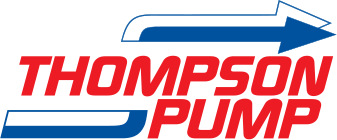Thompson Pump Meets Woodrow Wilson Bridge Application Challenge
As part of the massive 150-million dollar beltway project, a new 12-lane bridge will replace the existing Woodrow Wilson Bridge that spans the Potomac River, connecting Oxon Hill, Maryland, which is south of Washington D.C., with Alexandria, Virginia. The new Woodrow Wilson Bridge was designed to handle much more traffic than currently travels the bridge, and also allow for drawbridge access, pedestrian and bicycle access, and, eventually, a monorail system.
A joint venture between Tidewater Utilities, Kiewitt Construction and Clark Construction (TKC) – well-respected names in the construction industry – was created to start construction of the foundations for the bridge. Construction began with the installation of an intricate scaffolding system, and mobilization of two barges. The barges would support all of the equipment required to begin pouring concrete for the first of many bridge foundations. Large cofferdams of about 90-feet by 120-feet (large walls used to section off a body of water), were then installed to allow crews room to work.
Once the river water was removed from the inside of the cofferdam, crews started pouring the estimated 6,000-cubic feet of concrete into forms that would become the footings of the bridge. Sheet piling was installed to assist with forming the footings, and rebar was used to help secure the concrete. Once the pouring process started, it could not be stopped until all of the concrete was successfully poured. The pouring process took nearly 3 continuous days.
As the concrete was poured, crews found that water would seep in from the barriers and that river water was entering from the top of the cofferdam with the rise of the tide. Construction management began seeking advice from pump companies in the area on how to remove the water, without finding a solution to their problem – until they were referred to Pump & Power Equipment Co, a long-time Thompson Pump distributor in Jessup, MD.
Pump & Power Equipment representatives contacted Thompson Pump and combined expertise to begin devising a plan to remove the water. Thinking that a submersible pump could be used, it was found that the space between the sheeting and the foundation was too short to allow a submersible pump to be used. Overcoming this, Pump & Power and Thompson engineers devised a system that utilized lengths of 2” diameter PVC pipe and 90° elbows that were connected and suspended from the sheet piling. The PVC was long enough to reach the river floor. The run of PVC pipe that met the river floor was outfitted with a 90° elbow to ensure that water would not escape from the PVC pipe connections when the pump was non-operational.
Engineers devised a system consisting of long runs of PVC pipe and 90° elbows that reached the river floor in order to remove water that was entering where the concrete was to be poured.
A 4-inch and 6-inch Thompson Pump Vacuum-Assisted Dry Prime Pumps were used in order to meet the high head and lift conditions. A two-man, fully equipped service team was available on site throughout the 3-day concrete pouring process. If any problems occurred, they were there to address them immediately. With a limited working area, and below-freezing temperatures, the service team was a relief to construction management, by providing peace of mind during this delicate, time-sensitive process.
Thompson Pump, for more than 30-years, has been involved in some of the industry’s most difficult applications with great success – the first footing of the Woodrow Wilson Bridge was one of them. Thompson Pump is also proud to ally with helpful distributors like Pump & Power Equipment Co., who bring their expertise to complete the task-at-hand. The Pump & Power Equipment/Thompson Pump solution allowed the concrete to be poured successfully and work could continue on this massive project.
